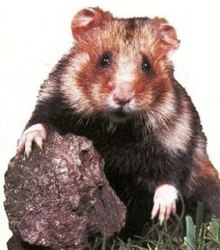European hamster: Difference between revisions
m Removed taxobox colour. See User:Eubot/Removing colours from taxoboxen. |
|||
| Line 26: | Line 26: | ||
==References== |
==References== |
||
* {{IUCN2006|assessors=Amori|year=1996|id=5529|title=Cricetus cricetus|downloaded=12 May 2006}} |
* {{IUCN2006|assessors=Amori|year=1996|id=5529|title=Cricetus cricetus|downloaded=12 May 2006}} |
||
*[http://www.hamster-club.com All about Hamsters] |
|||
{{Reflist}} |
{{Reflist}} |
||
Revision as of 13:03, 23 March 2008
| European Hamster Temporal range: Middle Miocene to Recent
| |
|---|---|

| |
| Scientific classification | |
| Kingdom: | |
| Phylum: | |
| Class: | |
| Order: | |
| Family: | |
| Subfamily: | |
| Genus: | Cricetus Leske, 1779
|
| Species: | C. cricetus
|
| Binomial name | |
| Cricetus cricetus Linnaeus, 1758
| |
The European Hamster, Cricetus cricetus, also known as the Black-bellied Hamster, is a species of hamster native to Europe. It is typically found in low-lying farmland with soft loam or loess soils, although it may also inhabit meadows, gardens, or hedges. It is widely considered a farmland pest, and has also been trapped for its fur. The black-bellied hamster is found from Belgium and Alsace in the west, to Russia in the east, and Romania in the south.
European hamsters are significantly larger than the Syrian hamsters or dwarf hamsters commonly kept as pets, being similar in size to guinea pigs.
In captivity, the European hamster has an unusually long life span, living up to eight years. They are very rarely kept as pets and have been known to attack large dogs if they feel threatened.
In 2007 the European Commission threatened to fine France €17m for failing to protect the last remaining colony of the Black-bellied Hamster in Western Europe[1].
References
- ^ "France faces huge fine for failing to save great hamster of Alsace". Independent. 2007-12-07.
{{cite news}}: Check date values in:|date=(help)

